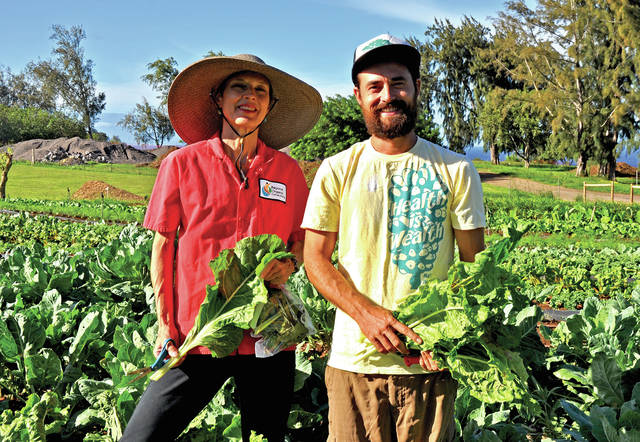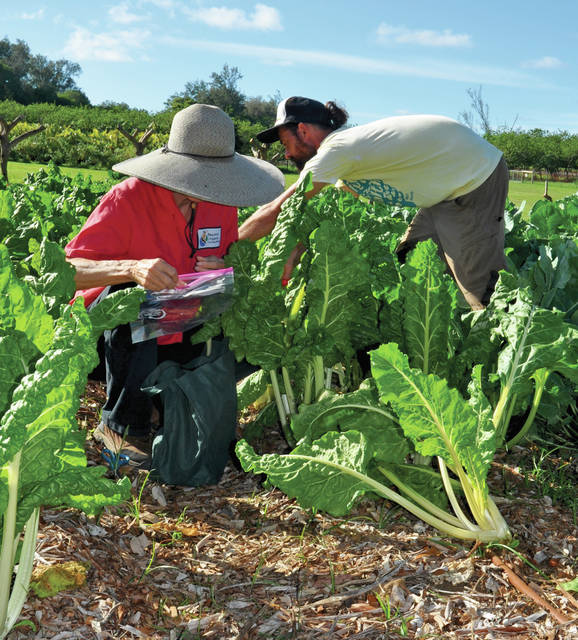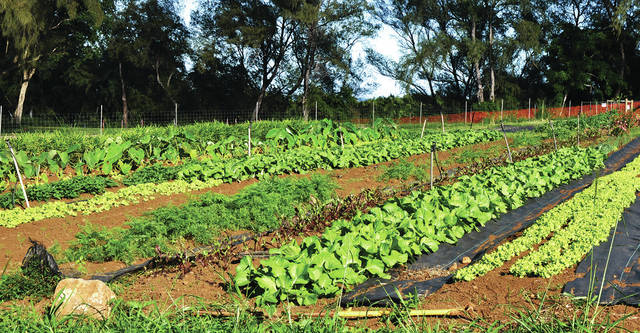Nutrient rich foods blossom in Kapaau: NFH project makes significant strides in 2017
KAPAAU — Grown the right way, foods can double or triple in nutrient content, according to Jana Bogs.
Nearly a year ago she received a grant that’s helping her prove just that.
“Our Nutrition Farming for Hawaii research and demonstration garden project in Kapaau has had excellent results with improving the soil and crops,” Bogs said. “In this soil study we are putting more natural fertilizers back in the soil. And this is just the beginning.”
Fiscally sponsored by North Kohala Community Resource Center (NKCRC), the project is run on a quarter-acre on HIP Ag’s farm. There, Bogs works with HIP’s farm manager Dash Kuhr and garden manager Nicholas Logan, in addition to various interns and Kohala School students.
Rows of kale, collards, chard, arugula, lettuce, basil, carrots, beets and green onions are among the produce tested there. They are also sold at the Hawi farmers market on Saturdays and used in Kohala School’s cafeteria.
“From an emotional perspective, I am very proud to be providing my community with the healthiest food that they can get,” Logan said.
Bogs started soil amendment in the garden in March, spreading needed nutrients across the soil.
“I have done mineral analyses on all these for human-needed nutrients like calcium, magnesium, phosphorus, potassium, zinc, iron, manganese, copper, sulfur and protein,” she said, which are done every six months.
“They show what minerals are lacking in soil and what we have too much of. It’s used to determine the exact amounts and forms of items needed,” she continued. “Other tested items include the total cation exchange capacity (TCEC), pH, electrical conductivity and organic matter percentage — all of which give a fuller picture of what needs to be corrected and how. I also do microbiological analyses on the soil, which is important because beneficial microbes make nutrients available to the plants.”
Unlike other analyses, Bog’s tests are more comprehensive.
“Nutrition Grown analysis has 18 minerals versus four minerals in the typical CTAHR analysis. It is also interpreted specifically for optimizing soil mineral balance and increasing nutrient content in the food,” she said.
Bogs and her team have made significant strides in improving the soil and nutritional content of their crops in the project’s first year.
“We have 15 times the beneficial microbes in the soil now, which help the plants uptake nutrients,” she said. “We’ve also improved the levels of eight minerals, and the nutrient-holding capacity of the soil and organic matter.”
Nutrient content in plant tissue tested from the research garden is already up to 10 times more than what USDA Food Nutrient Database values for some nutrients in some plants.
“Our goal is that through this research we may ultimately improve the nutritional qualities, flavor and yields of food crops starting from the soil up,” Bogs said. “Our overall mission is to improve human health and raise ecological awareness by instituting a paradigm shift in food cultivation practices which produce high yields of nutritionally-optimal foods using environmentally friendly methods.”
Motivated by a general loss of nutrient-dense soil in the U.S. and a lack of support from the USDA, Bogs earned her Ph.D. in horticulture and food science in 2009 from Colorado State University.
“We’ve seen minerals decrease in the soil over the last 50 years,” she said. “Back in 1936, Dr. Charles Northen was one of the first to do research on mineral depletion in American soils for the U.S. Senate. Over the last 100 years the U.S. has lost 85 percent of the minerals in the soil on average.”
Variations in nutrients found in produce depend on the soil’s condition, Bogs said.
“Increasing food’s nutritional content starts by improving the soil,” she reiterated. “The proper balance of minerals, organic matter and microbes can revitalize soil over time.”
In North Kohala, soil is highly variable from place to place — even on the same property sometimes.
“Overall, we usually need to add a lot of calcium to balance the higher levels of magnesium. Phosphorus, boron, cobalt and molybdenum are almost always low,” Bogs said. “Specific amounts of certain forms of minerals, humates, kelp and organic matter (compost) are needed, determined by test results.”
For $150, farmers and gardeners can hire Bogs to do a Nutrition Grown soil test on their land to measure the amount of nutrients found there which are then compared to ideal levels. When grown in nutrient-rich soil, produce can have fewer problems with pests and diseases, better flavor, longer shelf-life, higher yields and better nutrient content.
“Our overall goal is to grow better quality food by increasing the nutrient content in the soil, thus restoring nutrition in the island’s food supply,” Bogs said.
She wants to continue the research project for another three to five years, and is seeking further support.
“This coming year we’re hoping to obtain more grants and donations so we can continue our work at the garden to improve the soil. It’s also a source of nutrition-rich food for the community through the farmers market. In addition, the money would allow me to disseminate this information to other parts of the island and worldwide through the website,” she concluded.
Info or to donate to the project: Go to www.beyondorganicresearch.com





